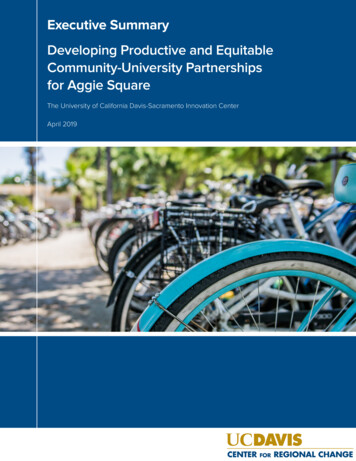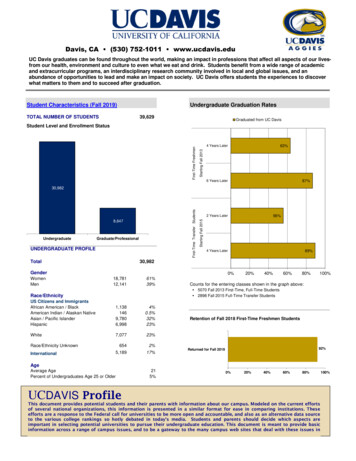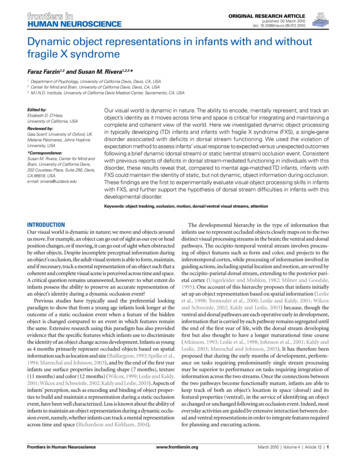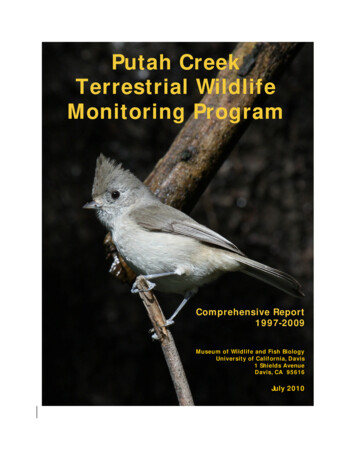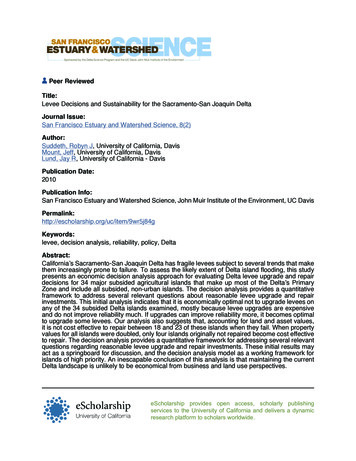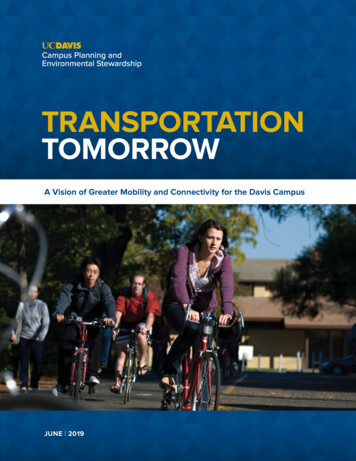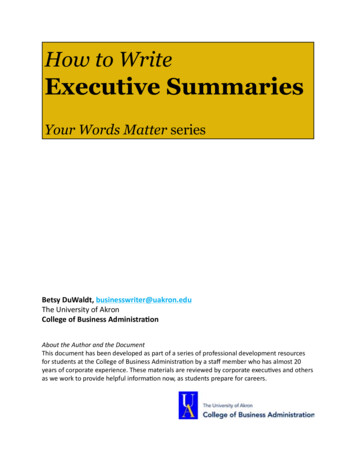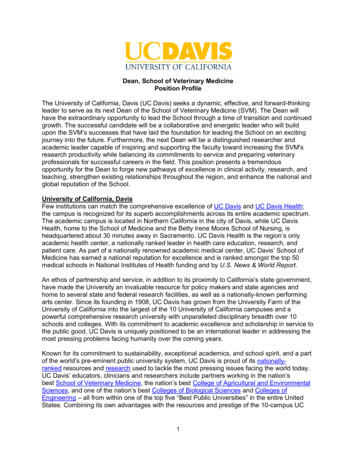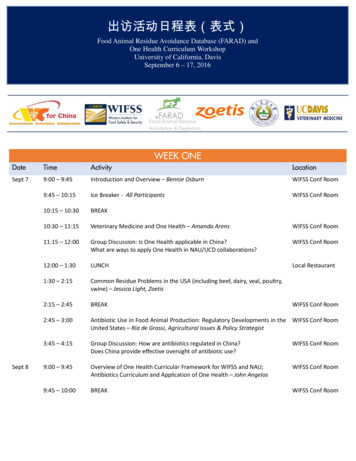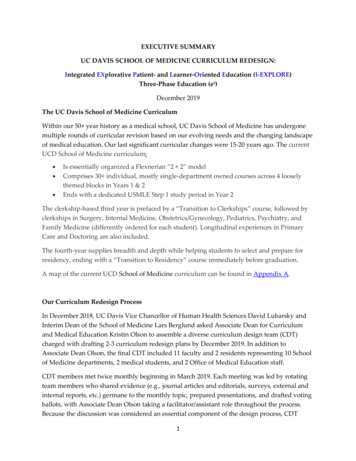
Transcription
EXECUTIVE SUMMARYUC DAVIS SCHOOL OF MEDICINE CURRICULUM REDESIGN:Integrated EXplorative Patient- and Learner-Oriented Education (I-EXPLORE)Three-Phase Education (e3)December 2019The UC Davis School of Medicine CurriculumWithin our 50 year history as a medical school, UC Davis School of Medicine has undergonemultiple rounds of curricular revision based on our evolving needs and the changing landscapeof medical education. Our last significant curricular changes were 15-20 years ago. The currentUCD School of Medicine curriculum: Is essentially organized a Flexnerian “2 2” modelComprises 30 individual, mostly single-department owned courses across 4 looselythemed blocks in Years 1 & 2Ends with a dedicated USMLE Step 1 study period in Year 2The clerkship-based third year is prefaced by a “Transition to Clerkships” course, followed byclerkships in Surgery, Internal Medicine, Obstetrics/Gynecology, Pediatrics, Psychiatry, andFamily Medicine (differently ordered for each student). Longitudinal experiences in PrimaryCare and Doctoring are also included.The fourth-year supplies breadth and depth while helping students to select and prepare forresidency, ending with a “Transition to Residency” course immediately before graduation.A map of the current UCD School of Medicine curriculum can be found in Appendix A.Our Curriculum Redesign ProcessIn December 2018, UC Davis Vice Chancellor of Human Health Sciences David Lubarsky andInterim Dean of the School of Medicine Lars Berglund asked Associate Dean for Curriculumand Medical Education Kristin Olson to assemble a diverse curriculum design team (CDT)charged with drafting 2-3 curriculum redesign plans by December 2019. In addition toAssociate Dean Olson, the final CDT included 11 faculty and 2 residents representing 10 Schoolof Medicine departments, 2 medical students, and 2 Office of Medical Education staff.CDT members met twice monthly beginning in March 2019. Each meeting was led by rotatingteam members who shared evidence (e.g., journal articles and editorials, surveys, external andinternal reports, etc.) germane to the monthly topic, prepared presentations, and drafted votingballots, with Associate Dean Olson taking a facilitator/assistant role throughout the process.Because the discussion was considered an essential component of the design process, CDT1
members only cast votes if they were present for the discussion. Proposals advanced if 2/3 ormore of the voting members voted in favor. Associate Dean Olson only cast tie-breaking votes,which occurred with 5% of proposals.Our timeline was ambitious, but unavoidably so given the gravity of the community concernsregarding the curriculum and the upcoming LCME visit in January 2022. Because we had notundertaken significant curriculum redesign in some time, there were many issues to consider ina short period. We needed to proceed quickly and efficiently, while making every effort to beinclusive, open-minded, and transparent about our process. Input was solicited from thebroader community via surveys, forums, meetings with department chairs and key departmenteducators, other one-on-one or small group discussions, presentations in committees, email,and a publicly available website.Why Does Our Curriculum Need to Change?We have evidence that our current curriculum is not fully achieving its intended purpose: Students have increasingly expressed their frustration with the structure, sequence,distribution, and content of the curriculum.Average USMLE Step 1 scores began declining several years ago and have sinceremained several points below the national average.Faculty have described the current content sequence as illogical from a knowledgescaffolding standpoint, and have described the process of introducing new content andintegrating content across courses and years as needlessly difficult.Leadership, faculty, and staff have expressed concern that our aged curriculum makesus less appealing to applicants with their pick of schools.External consultants have recommended curricular and structural modifications beforeour upcoming site visit in January 2022 to ensure compliance with Liaison Committeeon Medical Education (LCME) accreditation standards.Guiding Principles in RedesignOur guiding principles in redesign were organized around our School of Medicine missions,which together prioritize collaboration, diversity, community needs, and learner-centerededucation resulting in patient-centered care. The specific principles are listed in Appendix B.We hosted separate UCD School of Medicine community forums individually framed aroundthe principles of a learner-centered and patient-centered curriculum, which generated dozensof creative and thoughtful suggestions. A summary of these suggestions and how weincorporated them can be found in the full proposal.Our Framework for a New Curriculum2
Graduation competencies will serve as the primary scaffold for the curriculum,allowing for mapping of all courses and sessions. Emphasis will be on competencybased progression through the curriculum, with embedded opportunities for expandedlearning or remediation as appropriate for the learner.Three pillars of biomedical science, clinical science, and health systems science willbe horizontally and vertically integrated throughout the curriculum.Proposed PlansThe CDT created two plans (Blue and Gold) for consideration by our faculty committees. Theseplans are divided into three phases: pre-clerkship, clerkship, and post-clerkship. Key features ofthe pre-clerkship plans are compared in the table below. Specific descriptions for eachcourse/block are provided in Appendix C.Pre-ClerkshipStep 1 LocationFootprintBlue PlanBefore Core Clerkship phase91 weeks, beginning August andending in April65 weeks core content 4 weeks of intersessionsBegins after Human Architecture(see below)LongitudinalClinicalExperienceSummer Break8 weeksProposed Blocks, Sequencing, and TimingHuman8 weeksArchitectureMolecular and6 weeksCellular MedicinePathogens and5 weeks (Hematology notHost Defenseincorporated)[Hematology],19 weeks (Hematology incorporated)Cardiology,Pulmonology, andNephrologyEndocrinology,16 weeksGastroenterology,and ReproductionSkin, Bones, and3 weeks (second to last)CapstonesBrain and8 weeks (last)BehaviorTransition to1 weekClerkship(after 8 weeks Step 1 Study)3Gold PlanAfter Core Clerkship phase74 weeks, beginning August andending in December61 weeks core content 4 weeks of intersessionsBegins after Human Architecture(see below)4 weeks7 weeks5 weeks7 weeks (Hematology incorporated)16 weeks (Hematology notincorporated)15 weeks3 weeks (last)7 weeks (second to last)1 week
Commonalities Across Both Plans-Better integration across disciplines increases efficiency (merge, shift, or reduce totalhours by 20%) and limits extraneous cognitive load.Weekly schedule is standardized, with problem-based learning (PBL), team-basedlearning (TBL), and peer instruction (PI) the primary teaching methodologies as shownin this sample schedule:8:00 AM9:00 AM10:00 AM11:00 AM12:00 PM1:00-5:00 PMMONDAYPBL Prep Case 1PBL Prep Case 2TBLTBLLunchSDL timeTUESDAYSDL timeSDL timeARS LectureARS LectureLunchClinic orDoctoring*WEDNESDAYPBL Case 1Peer InstructionTBLTBLLunchTHURSDAYSDL timeSDL timeSDL timeSDL timeLunchFRIDAYPBL Case 2Peer InstructionPeer InstructionPeer InstructionLunchSDL timeSDL timeSDL timeSDL Self-directed Learning (view online lectures, self-directed learning). *Clinic and Doctoring (ClinicalSkills) can occur on any other PM to divide class evenly across days. All exams will be scheduled onFridays, whenever possible.---Advanced biomedical content is shifted to post-clerkship phase.Intersession content between coursework allows for customization and includeselectives, interprofessional education, specialty exposure, areas of scholarlyconcentration, and remediation if needed.Incorporation of previously underrepresented disciplines/topics such as anesthesiology,urology, otolaryngology, ophthalmology, radiation oncology, physical medicine andrehabilitation, toxicology, and pediatrics expands learner knowledge base.Optional lunch-time seminar series is opportunity for faculty to share advances inresearch and anticipated changes in medicine.Proposed Core Clerkship PhaseThe clerkships have an identical structure in both the Blue and Gold plans, though there isgreater need in the Gold plan to incorporate more biomedical science into this phase. This couldbe accomplished through team teaching on clerkships, optional evening sessions duringclerkships, and/or intersession content.-48 weeks of clerkships and intersessions combined and 4 weeks of vacation 7 blocks of 6 weeks each 42 weeks total of clerkship time§ Internal medicine§ Surgery§ Pediatrics§ OB/GYN4
-§ Psychiatry§ Family Medicine (can be 4 weeks 2 weeks of Selectives, if capacity is restricted)§ Selectives (3 x 2 weeks each) 6 weeks of intersessions:§ Biomedical, clinical, health science integration§ Areas of scholarly concentration§ Doctoring 3§ Interprofessional education§ Thread content§ Orientation for following clerkshipNeurology becomes a new required 4-week long clerkship in the post-clerkship phaseThe Primary Care Continuity Clinic is dissolved in lieu of the longitudinal clinical experience inthe pre-clerkship period.Proposed Post-Clerkship PhaseThe proposed post-clerkship phase differs for the Blue and Gold plans due to the potential shiftof Step 1.Post-ClerkshipLengthRequired ContentProposed RequirementsEmergency Medicine AINeurologyInpatient AIAdditional AIICUAdditional electiveweeksTransition to ResidencyStep 1 StudyBlue Plan65 weeks36 weeksGold Plan82 weeks40 weeks4 weeks at UCDMC4 weeks – Advanced Clinical Clerkship4 weeks in core clerkship department at UCDMC4 weeks (can be away rotation)4 weeks16 weeks20 weeks(4 weeks can apply towards ASC) (4 weeks can apply towards ASC)4 weeks, including specialty-specific biomedical contentNot applicable8 weeksAI Acting Internship; ICU Intensive Care Unit; ASC Area of Scholarly ConcentrationFor separate complete timelines of each plan that incorporate pre-clerkship, clerkship, and postclerkship phases, please see Appendix D.A summative comparison of the plans across all phases with the current curriculum isalso provided below.5
PhaseStep 1 PlacementPre-ClerkshipContent WeeksIntersessionsLongitudinalClinical ExperienceSummer BreakOther VacationClerkshipFamily MedicineInternal sContinuity ClinicIntersessionsVacationPost-ClerkshipRequired ContentEmergencyMedicine AINeurologyInpatient AIAdditional AIICUArea of ScholarlyConcentration(ASC)Additional electiveweeksTransition toResidencyCurrentBefore clerkships(March-April Year 2)91 weeksAugust - April71 weeksNoneBlue PlanBefore clerkships(March-April Year 2)91 weeksAugust - April65 weeks4 weeksGold PlanAfter clerkships(Jan-Feb Year 3)74 weeksAugust - December61 weeks4 weeksNoneBegins Week 9Begins Week 85 weeks7 weeks52 weeks4 weeks8 weeks8 weeks8 weeks8 weeks8 weeks4 weeks8 weeks5 weeks4 weeks5 weeksNone4 weeks65 weeks38 weeks52 weeks6 weeks6 weeks6 weeks6 weeks6 weeks6 weeks6 weeksMoved to pre-clerkship and increases toapproximately 28 half days6 one-week intersessions4 weeks65 weeks82 weeks36 weeks40 weeks4 weeks at UCDMC4 weeks at UCDMCNone4 weeks in core dept atUCDMC4 weeksNo ICU requirement4 weeks18 half days4 weeks in core clerkship department at UCDMC4 weeks (can be away rotation)4 weeks4 weeks (optionalDoctoring 4 or SPO)4 weeks (optional)12 weeks16 weeks16 weeks if no ASC20 weeks if no ASC4 weekswith specialty-specific biomedical science20 weeks2 weeks6
VII. Benefits and Drawbacks to Moving USMLE Step 1The timing of the USMLE Step 1 study period and exam within the curriculum has been a topicof animated discussion in medical schools across the country. As of 2017-2018, 17 medicalschools have shifted USMLE Step 1 from its traditional location at the end of the pre-clerkshipphase to the end of the core clerkship phase. An additional four schools allow students to takeUSMLE Step 1 at any point in the curriculum before graduation.Benefits to moving USMLE Step 1 Greater student engagement expected in pre-clerkship curriculum; currently, students arevery focused on a “parallel curriculum” of commercial board review productsPotential increase in Step 1 scoresPotential for fewer Step 1 failuresShelf exams offer preparation for Step 1, rather than the reverseContent overlap of USMLE Step 1 and Step 2CK increases studying efficiencyGreater emphasis on integrating biomedical science in clerkship/post-clerkship phasesNeutral aspects to moving USMLE Step 1 Students start clerkships without having consolidated pre-clerkship knowledge by studyingfor Step 1Shortening of pre-clerkship curriculum is balanced with lengthening of post-clerkship phaseDrawbacks to moving USMLE Step 1 Students complete clerkships without knowing their Step 1 score (and, to some extent, theircompetitiveness for residencies)Students can experience stress later in clerkship year as the Step 1 study period nearsIncorporating biomedical science in the clerkship year can be challengingSummer break in the pre-clerkship curriculum becomes shorter, limiting extramuralopportunitiesNo clear mandate at UCD School of Medicine for using the time transferred from the preclerkship to post-clerkship phase.Key stakeholders at the national level have been discussing USMLE scoring, its use inundergraduate and graduate education, and whether USMLE Step 1 should become pass/fail ora variant thereof. It is anticipated that a decision will be rendered in the near future (winter2019-2020) as to whether USMLE scoring should change.VIII. Curricular Oversight and Structural SupportWe propose that all departments share ownership of the 7 pre-clerkship courses/blockshighlighted above. This structure would offer numerous benefits, including increased andimproved inclusiveness, collaboration, and integration, through the following mechanisms:7
Foundational and longitudinal content format for all disciplinary areas (which iscurrently more challenging to offer with many individual courses)Spiral learning that builds upon and incorporates prior contentAssessments with greater integration and complexity, better reflecting the realities ofclinical medicine and USMLE examsBetter usage of our large pool of faculty expertiseCourse Director Selection A call shall be put out to all faculty, outlining the course content and the course directorresponsibilities.Applicants are reviewed jointly by the CEP chairs and curriculum dean, and finalists areinterviewed and selected by the CEP chairs, one CEP representative, and the curriculumdean. (This model is currently in use at the University of California at Los AngelesSchool of Medicine.)Three funded co-course directors: one faculty member from biomedical science, onefrom clinical science, and one from health systems science.CEP is encouraged to select faculty from different departments to serve as coursedirectors, to ensure inclusion and representation of as many departments as possible inoverseeing the curriculum.Consideration to a call being put out for applicants every three years while recognizingthat the “termed out” faculty may stay on if other qualified candidates are not identified.Thread Leaders, Discipline Leaders, and Competency Leaders Thread leaders will be preserved in this model, with funded discipline (anatomy,physiology, pharmacology, pathology, etc.) leaders added as well.Discipline leaders will be responsible for collaborating with course directors to ensurethat their disciplinary content is appropriately developed over the four years of thecurriculum.The CEP workgroup will select thread and discipline leaders through a mechanism likethat used for course directors.Faculty may serve in more than one educational role (e.g., course director and disciplineleader, or course director and thread leader) when deemed appropriate.IX. Metrics to Evaluate the New CurriculumEstablishing metrics for evaluation of the new curriculum will be important from a continuousquality improvement standpoint. We will need to understand the successes within the newcurriculum, as well as the curricular components that warrant further revision/refinement. Anabbreviated list of proposed institutional metrics includes, but is not limited to: Graduation Competencies (GC)8
Map courses and sessions to GC framework.Track and report student attainment of GC milestones.LCME Curricular Element Compliance Review curriculum in context of elements most commonly cited. Review curriculum in context of elements most challenging for our institution. Review curriculum in context of elements most recently introduced/modified.AAMC Graduation Questionnaire Track and report annual trends. Correlate results with feedback from courses and curricular phases.Student Feedback (Faculty, course, and curriculum evaluations) Track and report annual trends, including faculty response.Faculty Satisfaction Track and report satisfaction with curriculum (e.g., content, sequence,integration, ease of modifying content, course leadership). Track and report satisfaction with teaching experience (e.g., studentengagement and learning, collaboration with other faculty). Track and report satisfaction with institutionally-provided support (e.g., staff,technology tools, faculty development, funding).Curricular Content and Delivery Incorporate three pillars, five threads, and core clinical presentations. Align with USMLE Content Outline and national organization learningobjectives and competencies as appropriate. Conduct and report periodic faculty peer review. Monitor quality, type, and number of active learning sessions. Monitor outcomes of early clinical exposure in pre-clerkship phase. Monitor adherence to weekly contact hours policy in pre-clerkship phase. Monitor adherence to duty hours policy in clerkship and post-clerkship phases.Student progression and development Monitor student progression through coursework. Monitor student preparedness for clerkships and post-clerkship period,including clinical skills acquisition, and efficacy of any remediation efforts. Monitor student accomplishment of expected clinical encounters/procedures atappropriate levels of responsibility. Monitor outcomes of early specialty exposure in pre-clerkship phase. Monitor formal availability and participation in mentorship and researchopportunities. Monitor participation in and outcomes of areas of scholarly concentration. Monitor measures of student wellness in collaboration with Student Affairs.Standardized Exam Performance – Step 1, Step 2 CK, Step 2 CS, and CPX Report annual trends in USMLE and CPX performance. Compare average class performance to anticipated class performance.Residency and Match Outcomes Report residency match rates for our students. 9
Report students who matched into discipline of choice.Survey program directors regarding graduate preparedness as interns.Survey graduates regarding UME experience and preparation for residency.X. Next Steps After Plan SelectionOnce a plan is selected, Associate Dean Olson will continue to collaborate with faculty toembark on implementation planning for each stage of the curriculum. Additional resourcesneeded for plan implementation are described in Appendix E. Detailed plans can be found inthe full proposal.10
Appendix A. Current UCD School of Medicine Curriculum Map11
Appendix B. Mission-Oriented Curricular ElementsLearner-Centered Elements in the New Curriculum Increased emphasis on Step 1-relevant content and assessment methods, such as peer instruction,weekly formative quizzes, and NBME custom exams and NBME-style highly integrated examsEfficiency in learning through more effective integration, minimization of extraneous cognitive load,and schedule standardizationIncreased time for self-directed learning and student wellbeinge-Learning opportunities for increased flexibility (more online lectures in pre-clerkship curriculum andonline coursework for the post-clerkship period)Customization of student learning experience during intersessions (“discipline days,” areas of scholarlyconcentration, increased clerkship “selectives” to choose from, and more opportunities and support forremediation)Increased emphasis on clinical reasoning throughoutUse entrustable professional activities as a framework for assessment to allow for more frequentlearner feedback and greater clarity surrounding learner progression toward readiness for residencyOptimize preparedness for residency programs through increased career advising through directmentorship and strengthening the curriculum as suggested by internal residency program directorsEnhance student wellbeing and reduce burnout, and is hypothesized to result in higher USMLE Step 1scores, through high quality mentorship.Addition of neurology as a required clerkship, as petitioned for by our students and faculty (Appendix8)Patient-Centered Elements in the New Curriculum Advocating for and meeting the workforce needs of our communities through training more primarycare physicians, specialists, and researchers that directly contribute to serving these communitiesPrioritizing understanding of the diseases and health care issues of greatest concern for our localcommunities as outlined in our Community Health Needs Assessment, such as diabetes mellitus,asthma, cancer, and mental health, and the need for more active living and healthy eatingExperiencing the “whole patient” perspective – patient signs, symptoms, goals, values, and need forfunctionality, as well as the family caregiver perspectiveProviding more simulation experiences and standardized patients experiences to better preparestudents for caring for clinical experiencesIncorporating new patient-centered threads: diagnostic medicine (including point of care ultrasound),stages of life with fictional families whose health care issues evolve over time (including contentrelating to pediatrics, geriatrics, sex/gender differences, chronic illness and disability, death and dying),care for vulnerable populations (including social determinants of health), and preventive medicine(including nutrition, obesity, exercise, sleep, wellness, alcohol, tobacco, and cancer prevention); thesewill join the already established pain medicine thread.Combined Learner- and Patient Centered Elements in the New Curriculum Earlier clinical experience beginning in the first year, which is particularly important for thecontextualization of biomedical and health systems science:12
The “third pillar” of health systems science, which encompasses much of the complexity of health caredelivery for the patient, learner, and practicing physician.Greater emphasis on team-based care and interprofessional education to prepare learners for ourcomplex health care system.Emphasizing greater compassion and empathy for patients, in part through addressing wellness andburnout issues in students.Expanding on Our Strengths Incorporating main campus expertise in topics such as veterinary medicine, agricultural science, globalhealth, public health, social science, and informatics into the new curriculum.Capitalizing on our location in Sacramento to offer firsthand experience in health care advocacy andpolicy, with the state capitol building only a few miles away.Offering opportunities for students to fully benefit from our expertise and leadership in primary careand clinical/translational research.13
Appendix C. Pre-Clerkship Blocks for Blue PlanHuman Architecture and Function: Gross anatomy, microscopic anatomy (normal histology), clinical historyand physical examination skills, and health systems science are merged into one integrated experience. Theclass may be divided periodically into groups that rotate through different elements of the course, includinglecture, cadaveric dissection, and clinical skills training for the corresponding regions of the human body. Thisapproach has the benefit of easing the burden on the current anatomy lab, which is currently at capacity forspace. Anatomic prosections may be used in lieu of some dissection experiences, with the potential forassistance in preparing prosections from some surgical specialty departments (e.g., orthopaedic surgery).Embryology and/or radiology content could be shifted out into the organ systems to allow for morelongitudinal reinforcement of anatomic concepts and to decompress this course. Advanced concepts inanatomy and microscopic anatomy can be shifted to the post-clerkship period as specialty-specific biomedicalscience instruction for smaller groups of students. For example, a more detailed understanding of head andneck gross and microscopic anatomy and neuroanatomy could be provided over a week-long period in thepost-clerkship phase for students entering otolaryngology, ophthalmology, neurology, or neurosurgery,building upon the more basic anatomy instruction that all students received in the pre-clerkship phase.Weekly schedule standardization does not yet take effect for this segment given the logistical complexity,though recorded lectures, active learning, and half days of free study time are encouraged where feasible.Total time 8 weeks, 24 contact hours per week.Molecular and Cellular Medicine: Genetics, biochemistry, physiology, pharmacology, general pathology,clinical skills and experiences, and health systems science (including health and humanity) are merged intoone integrated course. Basic, foundational principles are taught here in preparation for the longitudinalexploration of organ-specific molecular and cellular medicine in the organ systems. The afternoon longitudinalclinical preceptor experience begins during this course, alternating with clinical skills content one half-dayevery other week. Weekly schedule standardization of active learning on MWF mornings. The first week-longintersession occurs immediately after this course. Total time 6 weeks, 24 contact hours per week.Pathogens and Host Defense. Basic, foundational principles are taught here in preparation for thelongitudinal exploration of organ-specific medical microbiology, immunology, and pharmacology. Healthsystems science content (including health and humanity) is included as well. Afternoon clinical preceptorexperiences alternate with clinical skills content one half-day every other week. Weekly schedulestandardization occurs with active learning on MWF mornings. Total time 5 weeks, 24 contact hours perweek.Winter break lasts two weeks, followed by the second week-long intersession at the start of January.Hematology, Cardiology, Pulmonology, and Nephrology. Full integration of biomedical science (“normal”),clinical science (“abnormal”), and health systems science (including health and humanity) occurs in this coursefor hematology, cardiology, respiratory, and renal topics. Relevant genetics, biochemistry, physiology,pathology, pathophysiology, pharmacology, immunology, microbiology, and threads are included. Afternoonclinical preceptor experiences alternate with clinical skills content one half-day every other week. Weeklyschedule standardization occurs with active learning on MWF mornings. The third week-long intersessionoccurs midway through this course, immediately before spring break. Total time 19 weeks, 24 contact hoursper week.14
Summer break – 8 weeks long (an increase of 3 weeks) with a timing shift to June and July. This is to alignbetter with the traditional summer break and allow for more national, regional, and local summerextracurricular opportunities for our students, including in research.Endocrinology, Gastroenterology, and Reproduction. Full integration of biomedical science (“normal”),clinical science (“abnormal”), and health systems science (including health and humanity) occurs in this coursefor endocrinology, gastroenterology, and reproduction. The male GU system is incorporated intoreproduction. Relevant genetics, biochemistry, physiology, pathology, pathophysiology, pharmacology,immunology, microbiology, and threads are included. Afternoon clinical preceptor experiences alternate withclinical skills content one half-day every other week. Weekly schedule standardization occurs with activelearning on MWF mornings. The fourth week-long intersession occurs midway through this course. Total time 16 weeks, 24 contact hours per week.Skin, Bones, and Capstones. Full integration of biomedical science (“normal”), clinical science (“abnormal”),and health systems science (including health and humanity) occurs in this course for musculoskeletal anddermatologic medicine. Relevant genetics, biochemistry, physiology, pathology, pathophysiology,pharmacology, immunology, microbiology, and threads are included. Embedded throughout this course areoccasional capstone cases that bring together multiple systems, particularly with musculoskeletal ordermatologic manifestations. Afternoon clinical preceptor experiences alternate with clinical skills content onehalf-day every other week. Weekly schedule standardization occurs with active learning on MWF mornings.Total time 3 weeks, 24 contact hours per week.Winter break lasts two weeks.Brain and Behavior. Full integration of biomedical science (“normal”), clinical science (“abnormal”), andhealth systems science (including health and humanity) occurs in this course for neuroanatomy, neuroscience,psychiatry, and bioethics. Head, neck and eye disease is incorporated. Relevant genetics, biochemistry,physiology, pathology, pathophysiology, pharmacology, immunology, microbiology, and threads areincluded. Embedded throughout this course are occasional capstone cases that bring together multiplesystems, particularly with neurologic, otolaryngologic, or ophthalmologic manifestations. Afternoon clinicalpreceptor experiences alternate with clinical
-Neurology becomes a new required 4-week long clerkship in the post-clerkship phase The Primary Care Continuity Clinic is dissolved in lieu of the longitudinal clinical experience in the pre-clerkship period. Proposed Post-Clerkship Phase The proposed post-clerkship phase differs for the Blue and Gold plans due to the potential shift of Step 1.
